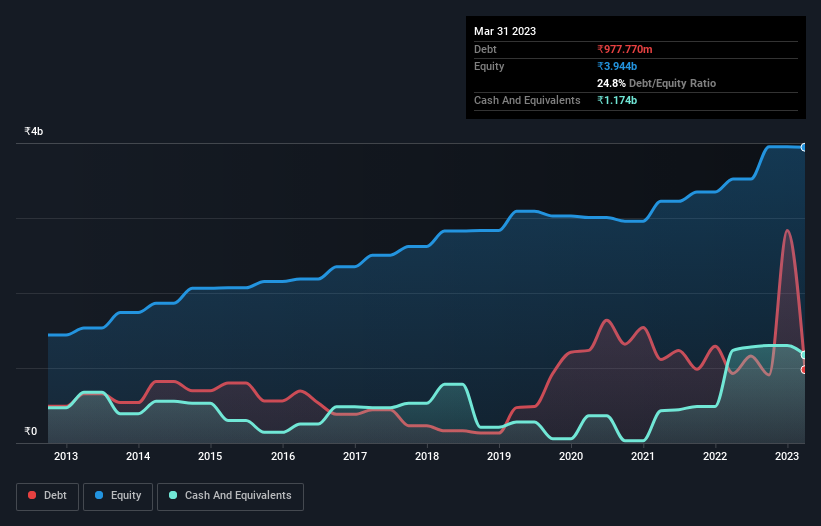- India
- /
- Auto Components
- /
- NSEI:MUNJALAU
Munjal Auto Industries (NSE:MUNJALAU) Takes On Some Risk With Its Use Of Debt
The external fund manager backed by Berkshire Hathaway's Charlie Munger, Li Lu, makes no bones about it when he says 'The biggest investment risk is not the volatility of prices, but whether you will suffer a permanent loss of capital.' It's only natural to consider a company's balance sheet when you examine how risky it is, since debt is often involved when a business collapses. Importantly, Munjal Auto Industries Limited (NSE:MUNJALAU) does carry debt. But is this debt a concern to shareholders?
What Risk Does Debt Bring?
Debt is a tool to help businesses grow, but if a business is incapable of paying off its lenders, then it exists at their mercy. In the worst case scenario, a company can go bankrupt if it cannot pay its creditors. However, a more common (but still painful) scenario is that it has to raise new equity capital at a low price, thus permanently diluting shareholders. Of course, plenty of companies use debt to fund growth, without any negative consequences. When we examine debt levels, we first consider both cash and debt levels, together.
Check out our latest analysis for Munjal Auto Industries
What Is Munjal Auto Industries's Debt?
The image below, which you can click on for greater detail, shows that at March 2023 Munjal Auto Industries had debt of ₹977.8m, up from ₹927.5m in one year. But it also has ₹1.17b in cash to offset that, meaning it has ₹196.7m net cash.

How Healthy Is Munjal Auto Industries' Balance Sheet?
According to the last reported balance sheet, Munjal Auto Industries had liabilities of ₹6.42b due within 12 months, and liabilities of ₹2.40b due beyond 12 months. On the other hand, it had cash of ₹1.17b and ₹4.39b worth of receivables due within a year. So its liabilities total ₹3.25b more than the combination of its cash and short-term receivables.
Munjal Auto Industries has a market capitalization of ₹5.68b, so it could very likely raise cash to ameliorate its balance sheet, if the need arose. But we definitely want to keep our eyes open to indications that its debt is bringing too much risk. Despite its noteworthy liabilities, Munjal Auto Industries boasts net cash, so it's fair to say it does not have a heavy debt load!
Shareholders should be aware that Munjal Auto Industries's EBIT was down 22% last year. If that decline continues then paying off debt will be harder than selling foie gras at a vegan convention. When analysing debt levels, the balance sheet is the obvious place to start. But it is Munjal Auto Industries's earnings that will influence how the balance sheet holds up in the future. So when considering debt, it's definitely worth looking at the earnings trend. Click here for an interactive snapshot.
Finally, a business needs free cash flow to pay off debt; accounting profits just don't cut it. While Munjal Auto Industries has net cash on its balance sheet, it's still worth taking a look at its ability to convert earnings before interest and tax (EBIT) to free cash flow, to help us understand how quickly it is building (or eroding) that cash balance. Happily for any shareholders, Munjal Auto Industries actually produced more free cash flow than EBIT over the last three years. There's nothing better than incoming cash when it comes to staying in your lenders' good graces.
Summing Up
Although Munjal Auto Industries's balance sheet isn't particularly strong, due to the total liabilities, it is clearly positive to see that it has net cash of ₹196.7m. The cherry on top was that in converted 131% of that EBIT to free cash flow, bringing in ₹52m. So while Munjal Auto Industries does not have a great balance sheet, it's certainly not too bad. When analysing debt levels, the balance sheet is the obvious place to start. But ultimately, every company can contain risks that exist outside of the balance sheet. We've identified 3 warning signs with Munjal Auto Industries , and understanding them should be part of your investment process.
At the end of the day, it's often better to focus on companies that are free from net debt. You can access our special list of such companies (all with a track record of profit growth). It's free.
New: Manage All Your Stock Portfolios in One Place
We've created the ultimate portfolio companion for stock investors, and it's free.
• Connect an unlimited number of Portfolios and see your total in one currency
• Be alerted to new Warning Signs or Risks via email or mobile
• Track the Fair Value of your stocks
Have feedback on this article? Concerned about the content? Get in touch with us directly. Alternatively, email editorial-team (at) simplywallst.com.
This article by Simply Wall St is general in nature. We provide commentary based on historical data and analyst forecasts only using an unbiased methodology and our articles are not intended to be financial advice. It does not constitute a recommendation to buy or sell any stock, and does not take account of your objectives, or your financial situation. We aim to bring you long-term focused analysis driven by fundamental data. Note that our analysis may not factor in the latest price-sensitive company announcements or qualitative material. Simply Wall St has no position in any stocks mentioned.
About NSEI:MUNJALAU
Munjal Auto Industries
Manufactures and sells auto components for motor vehicles in India.
Slight risk and slightly overvalued.
Market Insights
Community Narratives



